Abstract
Eight healthy volunteers received a 1,000-mg single oral dose of 2085P which consisted of 800 mg of pivampicillin and 200 mg of brobactam. Concentrations of ampicillin and brobactam in plasma, inflammatory fluid, and urine were measured over the subsequent 24 h. Pivampicillin and brobactam were moderately rapidly absorbed. The mean (standard deviation) maximum concentration in plasma (Cmax) of ampicillin was 8.2 (1.9) micrograms/ml, and that of brobactam was 2.1 (2.0) micrograms/ml at mean times of 1.9 (0.5) and 2.3 (0.8) h, respectively. The elimination half-lives in plasma were 1.8 (0.5) and 1.6 (2.0) h, respectively. Both agents penetrated the experimentally induced inflammatory fluid, reaching a mean maximum at 3 h. The Cmax of ampicillin was 6.8 (2.3) micrograms/ml, and that of brobactam was 1.0 (0.4) micrograms/ml. The penetration (derived by comparing the area under the concentration-time curve from 0 h to infinity for inflammatory fluid with that for plasma) was 97.3% (26.0%) for ampicillin and 81% (22.3%) for brobactam. The 24-h urinary recovery was 54.2% (16.6%) of the administered dose for ampicillin and 40.2% (11.4%) for brobactam. These data suggest that this combination of beta-lactam and inhibitor should be efficacious in treating infections caused by ampicillin-resistant pathogens.
Full text
PDF


Selected References
These references are in PubMed. This may not be the complete list of references from this article.
- Bennett J. V., Brodie J. L., Benner E. J., Kirby W. M. Simplified, accurate method for antibiotic assay of clinical specimens. Appl Microbiol. 1966 Mar;14(2):170–177. doi: 10.1128/am.14.2.170-177.1966. [DOI] [PMC free article] [PubMed] [Google Scholar]
- Hultberg E. R., Backelin B. Studies on the absorption of pivampicillin and ampicillin. Scand J Infect Dis. 1972;4(2):149–153. doi: 10.3109/inf.1972.4.issue-2.16. [DOI] [PubMed] [Google Scholar]
- Melchior N. H., Keiding J. In-vitro evaluation of ampicillin/brobactam and comparison with other beta-lactam antibiotics. J Antimicrob Chemother. 1991 Jan;27(1):29–40. doi: 10.1093/jac/27.1.29. [DOI] [PubMed] [Google Scholar]
- Verbist L. Triple crossover study on absorption and excretion of ampicillin, pivampicillin, and amoxycillin. Antimicrob Agents Chemother. 1974 Nov;6(5):588–593. doi: 10.1128/aac.6.5.588. [DOI] [PMC free article] [PubMed] [Google Scholar]
- Wise R., Andrews J. M., Patel N. 6-beta-bromo- and 6-beta-iodo penicillanic acid, two novel beta-lactamase inhibitors. J Antimicrob Chemother. 1981 May;7(5):531–536. doi: 10.1093/jac/7.5.531. [DOI] [PubMed] [Google Scholar]
- Wise R. Penicillins and cephalosporins: antimicrobial and pharmacological properties. Lancet. 1982 Jul 17;2(8290):140–143. doi: 10.1016/s0140-6736(82)91103-5. [DOI] [PubMed] [Google Scholar]


